Inscriptions of Nabopolassar from Babylon
Jump to Nabopolassar 1 Nabopolassar 2 Nabopolassar 3 Nabopolassar 4 Nabopolassar 5 Nabopolassar 6 Nabopolassar 7
This short Akkadian inscription of Nabopolassar, which is written in an archaizing Neo-Babylonian script, is preserved on seven single-column clay cylinders. Some of the cylinders were discovered during Koldewey's excavations at Babylon, while a few others came to light during Iraqi work on the site during the 1970s. This text, like the following two inscriptions (Npl. 2–3), records Nabopolassar's renovation of Imgur-Enlil, Babylon's inner wall. Although the inscription does not contain any specific historical references, it has been suggested that it was composed sometime between 622 and 612; the proposed date of this text is based on a statement in Npl. 3 (i 28–ii 5) in which the Babylonian king claims to have thrown off Assyrian domination. This text is sometimes referred to as "Nabopolassar Cylinder I, 1" or "[Nabopolassar] Imgur-Enlil (Short Version) Inscription (C11/A)."
Access the composite text [/ribo/babylon7/Q005360/] or the score [/ribo/bab7scores/Q005360/score] of Nabopolassar 1
Sources
| (1) VA 5952 (BE 29363) | (2) BM 26263 (98-5-14,81) |
| (3) A Babylon 4 | (4) IM 80017 |
| (5) B 13 (formerly D 248; BE 36495) | (6) IB 58 (formerly D 293; BE 41860) |
| (7) Carlos Museum 1921,131 |
Commentary
Exs. 1–2 and 4 are fully preserved. The master text is based on exs. 1 (VA 5952) and 4 (IM 80017). This forty-nine-word Akkadian inscription is generally written in nineteen lines (exs. 1, 3–5); in ex. 2 (BM 26263), and possibly also in ex. 7 (Carlos Museum 1921,131), it is distributed over twenty-one lines. The lineation of the edition in the present volume follows the nineteen-line version. A score is presented on Oracc and the minor (orthographic) variants are given in the critical apparatus at the back of the book. Exs. 5–6 were collated by N. Heeßel.
Bibliography
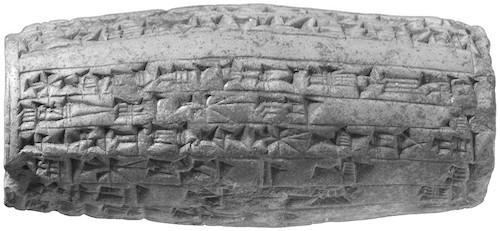
VA 5952 (BE 29363; Npl. 1 ex. 1), a single-column clay cylinder that is inscribed with a short Akkadian text stating that Nabopolassar rebuilt Babylon's inner wall Imgur-Enlil. © Staatliche Museen zu Berlin – Vorderasiatisches Museum. Photo: Olaf M. Teßmer.
Five small, single-column clay cylinders bear an inscription of Nabopolassar written in archaizing Neo-Babylonian script. Most of these objects were found by Iraqi archaeologists in the late 1970s, including one cylinder (ex. 2) that was housed in a clay foundation box deposited in Babylon's inner wall Imgur-Enlil by Nabonidus (the last native king of Babylon), between the Ištar Gate and Emaḫ, the temple of the goddess Bēlet-ilī; this box also contained another cylinder of Nabopolassar (Npl. 3) and a cylinder of Nabonidus (Weiershäuser and Novotny, RINBE 2 pp. 52–55 Nbn. 1 [Imgur-Enlil Cylinder] ex. 2 [A Babylon 10]). Like Npl. 1 (C11/A) and 3 (C32), this inscription records Nabopolassar's renovation of a section of Imgur-Enlil, in particular the stretch of the wall that ran between the Ištar Gate in the north and the Uraš Gate in the south. Although the cylinder is not dated, it has been suggested that the inscription was composed sometime between 622 and 612; the proposed date of the text is based on Npl. 3 (C32) i 28–ii 5, which states that Nabopolassar had thrown off the yoke of Assyria, but had not yet defeated (or killed) its king Sîn-šarra-iškun or turned its cities into ruins. The text is sometimes cited in scholarly literature as "[Nabopolassar] Imgur-Enlil (Short Version) Inscription (C11/B)."
Access the composite text [/ribo/babylon7/Q005361/] or the score [/ribo/bab7scores/Q005361/score] of Nabopolassar 2
Sources
| (1) IM 80016 | (2) A Babylon 12 |
| (3) A Babylon 6 | (4) A Babylon 7 |
| (5) IM 124170 (79-B-7) |
Commentary
Exs. 1 (IM 80016) and 2 (A Babylon 12) are the best-preserved exemplars. The former has a few damaged signs in lines 6–9, while the latter — which was discovered by Iraqi archaeologists in 1978 in a mud-brick box together with A Babylon 11 (Npl. 3 [C32] and A Babylon 10 (Weiershäuser and Novotny, RINBE 2 pp. 52–55 Nbn. 1 [Imgur-Enlil Cylinder] ex. 2) — is the only fully intact exemplar of this short, forty-six-word inscription. The master text follows ex. 2. The content of text is identical in exs. 1–3, while it is marginally different at the end of the inscription in exs. 4 (A Babylon 7) and 5 (IM 124170); those two exemplars have BÀD a-na dAMAR.UTU SIG₅-ti dAG-IBILA-ÙRU qí-bi ("O wall, speak favorable things about Nabopolassar to the god Marduk") in lieu of BÀD a-na dAMAR.UTU qí-bi SIG₅-ti ("O wall, speak favorable things about me to the god Marduk"). A score is presented on Oracc and the minor (orthographic) variants are given in the critical apparatus at the back of the book.
Bibliography
A large three-column clay cylinder discovered in a clay box by Iraqi archaeologists at Babylon in 1978 is inscribed with a long Akkadian inscription that records Nabopolassar's restoration of a stretch of Babylon's inner wall Imgur-Enlil; see the introduction of Npl. 2 (C11/B) for further details on the provenance and contents of the foundation box. Like the previous inscription, this text records that Nabopolassar's workmen rebuilt/renovated Imgur-Enlil along the banks of the Araḫtu River (modern Šaṭṭ al-Hillah), from the Ištar Gate in the north to the Uraš Gate in the south. During the renovations, a statue of an unnamed, previous ruler (possibly an Old Akkadian king, either Rīmuš, Man-ištūšu, or Narām-Sîn) was discovered. Because the inscription states that Nabopolassar had cast off the yoke of Assyria, but not yet that he had defeated (or killed) its king or destroyed its cities, the text may have been composed sometime between 622 and 612. The text, whose script is archaizing Neo-Babylonian, is occasionally referred to as "[Nabopolassar] Imgur-Enlil (Long Version) Inscription (C32)" in previous studies and editions.
Access Nabopolassar 3 [ /ribo/babylon7/Q005362/].
Source
| A Babylon 11 |
Commentary
Since the original was not available for study, because nearly all of the objects in the Nebuchadnezzar Museum (Babylon) are no longer accessible (as they are stored in sealed boxes), the present edition of A Babylon 11 is based on F. Al-Rawi's published hand-drawn facsimile (Iraq 47 [1985] figs. 1–3). Col. i 1–2, 29–ii 3, 37–iii 4 and 31–36, however, were collated from a published photograph (Al-Rawi, ibid. pl. 1). For an overview of the archaizing features in this text, see Da Riva, GMTR 4 pp. 85–88.
Bibliography
A large two-column clay cylinder, presumably from Babylon, is inscribed with an Akkadian inscription describing the rebuilding of Babylon's outer wall Nēmetti-Enlil by Nabopolassar; the script is archaizing Neo-Babylonian. This text is unusual since few Neo-Babylonian inscriptions record work on this wall; normally kings refer to their work on Babylon's inner wall Imgur-Enlil. The lack of historical references, the mention of the god Erra, and the fact that one of Babylon's walls is the main focus of the inscription, may point to this text being composed early in Nabopolassar's reign, sometime between 622 and 612; note the absence of any mention of the yoke of Assyria being cast off. The inscription is referred to as "Nabopolassar Cylinder II, 3," "[Nabopolassar] Nēmed-Enlil Inscription (C23)," or "[Nabopolassar] Nēmetti-Enlil Inscription (C23)" in scholarly literature.
Access Nabopolassar 4 [ /ribo/babylon7/Q005363/].
Source
| YBC 2309 |
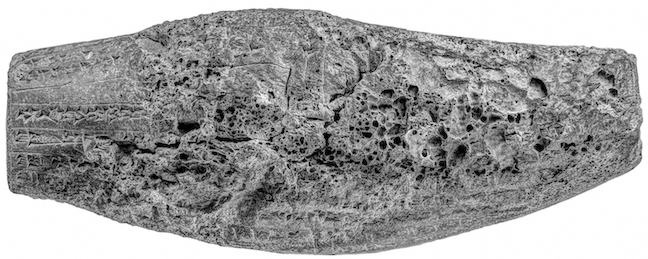
YBC 2309 (Npl. 4), a two-column clay cylinder that was damaged as the result of extreme heat. BC.16913 (YBC 2309), courtesy of the Yale Peabody Museum, Babylonian Collection. Photography by Klaus Wagensonner.
Commentary
According to A.T. Clay (BRM 4 p. 48 no. 51), this clay cylinder of Nabopolassar "was baked too long, which resulted in the cylinder losing its symmetrical shape, and in the injury of some of the text." R. Da Riva (GMTR 4 p. 62; and SANER 3 p. 73), following the suggestion of U. Kasten, suggests that YBC 2309 "must have burned on a wooden surface at a very high temperature" and that "the condition of the cylinder is reminiscent of that of the Kasr tablets," so probably originated from that spot in Babylon. The suggested find spot for this two-column clay cylinder is highly plausible given that many of the known inscriptions of Nabopolassar come from the Kasr. Given the object's assumed provenance and the fact that most of the Kasr tablets are vitrified on only one side, YBC 2309's damaged state was likely the result of it being buried by burning wood. The surface exposed directly to the extreme heat was badly damaged, while the surface that was against the floor was not as damaged since it was not exposed to the same high temperatures; see Pedersén, Archive und Bibliotheken p. 145. The authors would like to thank J. Hackl for bring this information to their attention.
Da Riva (SANER 3 p. 74), despite the damage to the cylinder, suggests that no lines are completely missing from the text. This, however, might not be the case since there could be two lines completely destroyed at the end of col. ii, although this cannot be proven since YBC 2309 is the only identified exemplar of this inscription of Nabopolassar. The text was collated from high-resolution photographs kindly provided by K. Wagensonner; see Da Riva, SANER 3 CD-ROM figs. 16a–n.
Bibliography
A fragment of a single-column clay cylinder discovered at Babylon (Kasr 26f) preserves part of an Akkadian inscription of Nabopolassar written in contemporary Neo-Babylonian script. This previously unpublished text records the rebuilding of Babylon's outer wall Nēmetti-Enlil. The prologue, as far as it is preserved, duplicates verbatim Npl. 7 (C12). Because the inscription alludes to Assyria's defeat (lines 5′–9′), the text's date of composition was likely sometime after 612 or 609.
Access Nabopolassar 5 [ /ribo/babylon7/Q005364/].
Source
| VA Bab 636 (BE 32654) |
Commentary
Lines 1′–9′ duplicate Npl. 7 (C12), so the proposed restorations are based on that inscription. Lines 10′–17′ are not presently duplicated elsewhere in the known Nabopolassar corpus, although line 16′b seems to parallel Npl. 4 [C23]) i 18.
Bibliography
Two three-column clay cylinders are inscribed with a text describing the rebuilding of the ziggurat Etemenanki, the temple-tower of the god Marduk at Babylon; the script of both exemplars is archaizing Neo-Babylonian. The text provides some interesting details about the early stages of the ziggurat's construction. Nabopolassar states that: (1) he made a variety of tools for the project, especially hoes, spades, and brickmolds made from precious materials; (2) master builders and other scholarly men (including diviners) ensured that the ziggurat was built on the exact spot as the previous one and that its dimensions were precisely the same as before; and (3) elaborate foundation rituals were performed, some of which included the pouring out and sprinkling of high quality liquids and aromatics. Nabopolassar, his heir and successor Nebuchadnezzar (II), and another son of his (Nabû-šumu-līšir) all personally participated in brick-laying ceremonies. The king boasts that he carried bricks on his head, perhaps the first brick(s) to be laid during the rebuilding of the superstructure. Since the defeat of Assyria is recorded, the date of composition is presumably after 612 or 609; the "Subarean" (= the Assyrian king Sîn-šarra-iškun) is said to have been killed and his land is reported to have been turned into ruins. The inscription is sometimes cited as "Nabopolassar Cylinder III, 1" or "[Nabopolassar] Etemenanki Inscription (C31)."
Access the composite text [/ribo/babylon7/Q005365/] or the score [/ribo/bab7scores/Q005365/score] of Nabopolassar 6
Sources
| (1) CBS 9090 | (2) BM 91090 (86-7-20,1) |
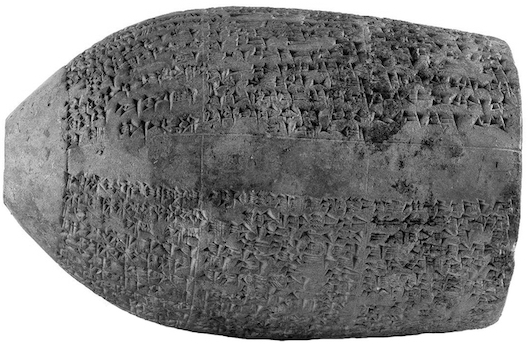
CBS 9090 (Npl. 6 ex. 1), a three-column clay cylinder of Nabopolassar bearing an inscription recording the rebuilding of Babylon's ziggurat Etemenanki. Courtesy of the Penn Museum, object no. B9090.
Commentary
The script of both exemplars is archaizing Neo-Babylonian; for an overview of the archaizing features in this text, see Da Riva, GMTR 4 pp. 85–88. Neither exemplar has rulings between the individual lines of text. Ex. 1 (CBS 9090) has vertical rulings between the columns, as well as a horizonal ruling at the end of the inscription. Ex. 2 (BM 91090), on the other hand, does not have rulings separating the three columns of text, so the ends of the lines of one column 'merges' with the beginnings of the lines of the next column. It does, however, use a single horizontal ruling to mark the first line of each column. For cols. i and ii of BM 91090, the last lines of those two columns were inscribed directly above the first lines of those columns, while in col. iii there is an uninscribed space of ca. twelve lines between the end of the inscription and the first line of col. iii; see Da Riva, SANER 3 CD-ROM fig. 17. The distribution of text of this inscription, which is the second longest attested inscription of Nabopolassar, differs significantly between exs. 1 and 2. The scribe of CBS 9090 (ex. 1) divided this 372-word Akkadian inscription into 42, 51, and 54 lines of text, while the person who wrote out the text on BM 91090 (ex. 2) split the inscription into 42, 68, and 60 lines. Because Ex. 1 is virtually complete, whereas ex. 2 is not, the master text and lineation of the edition presented here are based on ex. 1. A score is presented on Oracc and the minor (orthographic) variants are given in the critical apparatus at the back of the book. Both exemplars were collated from high-resolution photographs.
Bibliography
An Akkadian inscription of Nabopolassar recording the restoration of Eḫursagtila, the temple of the god Ninurta in the Šuanna district of Babylon, is preserved on six single-column clay cylinders; the script is contemporary Neo-Babylonian. Most of these hollow (barrel) cylinders were discovered during the German excavations at Babylon, in the ruins of the Ninurta temple (Ishin Aswad L27). Because Assyria's defeat is alluded to, the inscription's date of composition is likely sometime after the sack and destruction of Nineveh in late 612 or after the disappearance of Aššur-uballiṭ II in 609; the god Marduk (= Šazu) is said to have enabled the Babylonian king to kill his enemy (presumably the king of Assyria). The text is cited in scholarly publications as "Nabopolassar Cylinder I, 2" or "[Nabopolassar] é.PA.GÍN.ti.la Inscription (C12)."
Access the composite text [/ribo/babylon7/Q005366/] or the score [/ribo/bab7scores/Q005366/score] of Nabopolassar 7
Sources
| (1) VA Bab 630 (BE 14940) | (2) VA Bab 629 (BE 14488) |
| (3) VA Bab 631 (BE 14990) | (4) VA Bab 641 (BE 14239) |
| (5) VA Bab 1970 (BE 32254) | (6) Private collection |
Commentary
Exs. 1–4 were discovered during Koldewey's excavations at Babylon, while exs. 5 and 6 were purchased. Ex. 5 (VA Bab 1970) presumably comes from the Ninurta temple, whereas ex. 6, which was in the possession of F.S. Clark (Mayfield, Surrey, UK) in 1974, could have originated from either Ishin Aswad L27 or the Kasr. Because ex. 6 only preserves the presentation of the king and the īnu-clause narrating Nabopolassar's rise to power, it is not certain if the cylinder to which it belonged was inscribed with this text (C12) or Npl. 5 (VA Bab 636), a text recording work on Nēmetti-Enlil that has the same opening twenty-one lines as the present inscription. Despite its poor state of preservation, ex. 6 is tentatively edited as an exemplar of Npl. 7. Given the uncertainty of the Clark fragment's attribution, it is not known whether it originated from Ishin Aswad L27 (Ninurta temple) or the Kasr.
The script of all exemplars is contemporary Neo-Babylonian. Exs. 1–3 and 5 have horizontal rulings between every line of text, while ex. 6 is partially ruled and ex. 4 is not ruled. The lineation of the known exemplars is identical for this 273-word Akkadian inscription. The text is written in a single column, over forty-one lines.
The master text is a conflation of exs. 1–3 and 5, with preference for exs. 1 and 5, the best-preserved exemplars of the inscription. A score is presented on Oracc and the minor (orthographic) variants are given in the critical apparatus at the back of the book. Exs. 1–5 were collated from high-resolution photographs. The transliteration of ex. 6, however, is based on C.B.F. Walker's published transliteration (JCS 26 [1974] p. 67 no. 86) since no copy or photograph of that fragment are available. The original could not be consulted since its present whereabouts are not known.
Eḫursagtila, the temple of the god Ninurta at Babylon, is written as é-PA.GÍN-ti-la in this inscription of Nabopolassar. This form of the Sumerian ceremonial name, as already pointed out by A.R. George (Topographical Texts p. 314), is simply a scholarly writing of the better-attested é-ḫur-sag-ti-la. George states that "Nabopolassar's use of PA.GÍN for ḫur.sag is symptomatic of the contrived (and often misconceived) archaizing that is a hallmark of the royal inscriptions of the Chaldaean dynasty, and is no doubt owed to diligent consultation of the lexica (such as Igituḫ). This consideration incidentally vouches for the tenacity of a lexical tradition which passed down UD.GAL.NUN orthography to posterity some two millennia after that mode of writing fell into disuse." For further information on Eḫursagtila — which was situated in Šuanna (according to this inscription and Tintir = Babylon IV line 19), now Ishin Aswad, and which was excavated by German excavators in 1901 — see, for example, Koldewey, Tempel pp. 25–36 and pls. 6–7; Koldewey, WEB5 pp. 221–226; George, House Most High p. 102 no. 489; George, Topographical Texts pp. 313–314; and Pedersén, Babylon pp. 150–153.
Bibliography
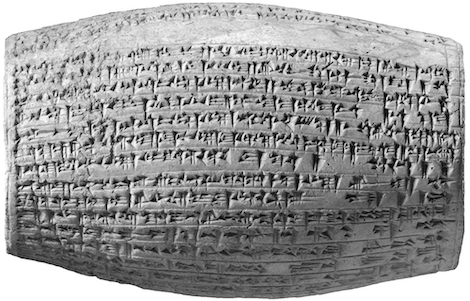
VA Bab 630 (BE 14940; Npl. 7 ex. 1), a single-column clay cylinder discovered in the ruins of Eḫursagtila bearing an inscription of Nabopolassar recording that he renovated that temple of the god Ninurta. © Staatliche Museen zu Berlin – Vorderasiatisches Museum. Photo: Olaf M. Teßmer.
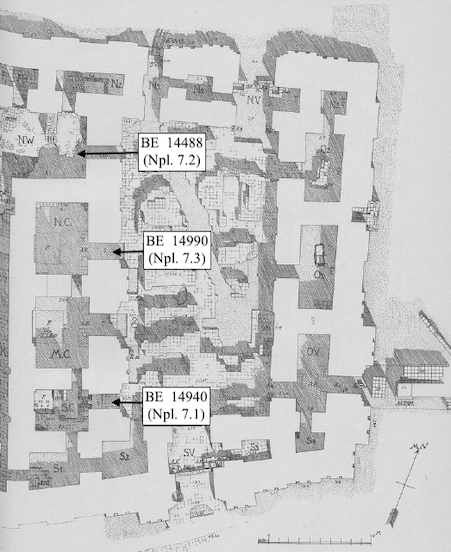
Annotated plan of the ruins of the Ninurta temple at Babylon showing the find spots of Npl. 7 exs. 1–3. Adapted from Koldewey, Tempel pl. 6.
Jamie Novotny & Frauke Weiershäuser
Jamie Novotny & Frauke Weiershäuser, 'Inscriptions of Nabopolassar from Babylon', RIBo, Babylon 7: The Inscriptions of the Neo-Babylonian Dynasty, The RIBo Project, a sub-project of MOCCI, 2025 [/ribo/babylon7/Rulers/Nabopolassar/Texts1-7Babylon/]